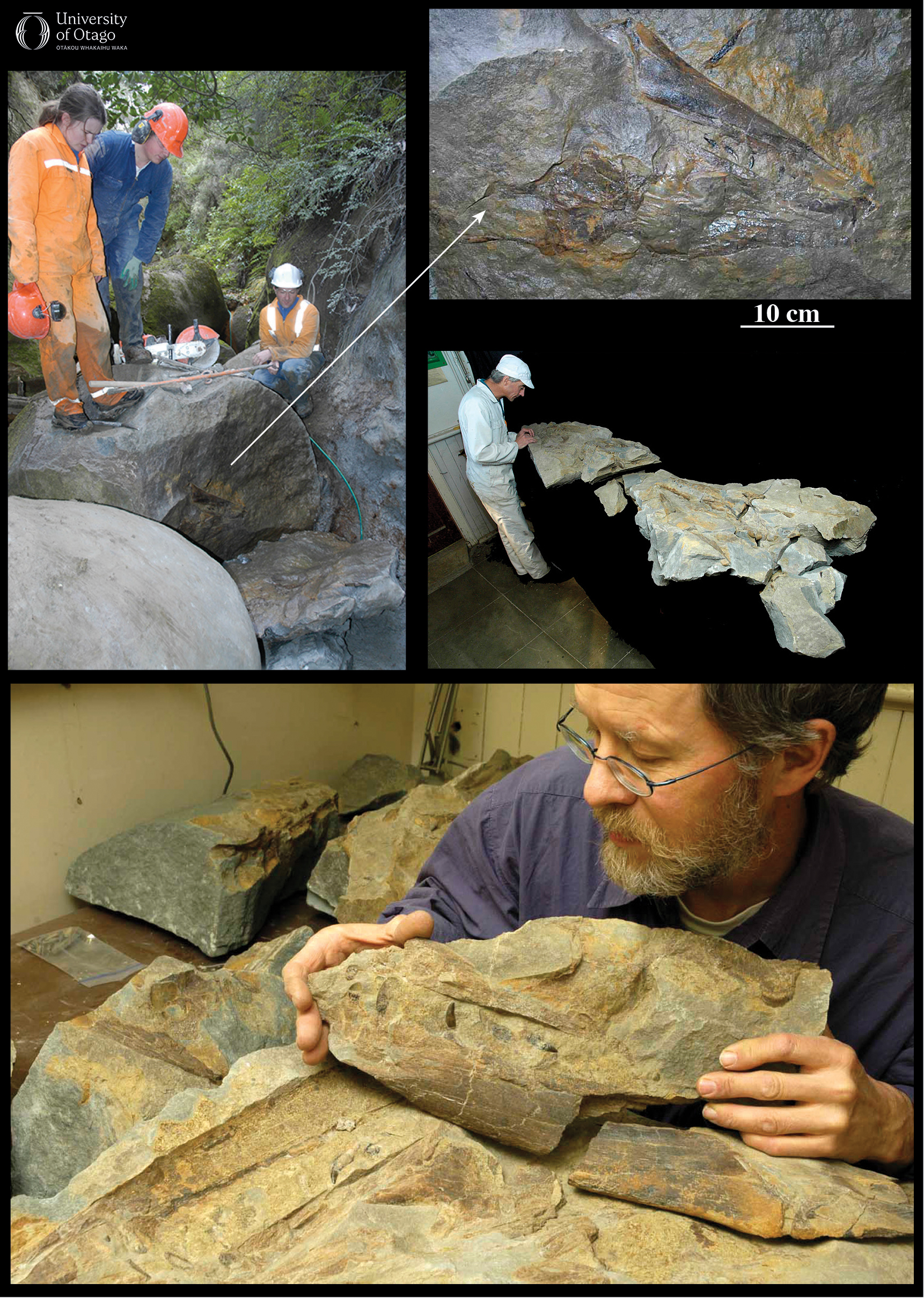12 Predator lizard discovered in the Waipara Valley
Sauropsida, Mosasauria
Mosasaurs are extinct marine lizards that are more closely related to geckos and skinks (te reo Māori: mokomoko) than they are to birds (te reo Māori: manu) and other dinosaurs. Unlike geckos and skinks though, mosasaurs grew to be several metres long and looked a little like large crocodiles with paddle-like flippers. Mosasaurs patrolled the world’s oceans for millions of years until around 66 million years ago when they became extinct along with non-avian dinosaurs, plesiosaurs and other animals during the great catastrophic extinction event at the end of Cretaceous times. Mosasaur fossils are not common discoveries in Aotearoa New Zealand but have been reported from a few regions around the country since the mid-1800s.
|
Collection and preparation of the mosasaur fossil from the Waipara Valley. Image credit: RE Fordyce. |
In April 2004 one of the most complete mosasaur skulls ever discovered in Aotearoa was found in the Waipara region of North Canterbury. The skull was from an animal that was perhaps 5 m long and shared similarities with another mosasaur found in the same region, Prognathodon waiparaensis. Before this discovery, fossil reptiles were last described from the Waipara region in 1971 by Samuel Welles (University of California, Berkeley) and Don Gregg (then Curator of Geology at Canterbury Museum). Welles and Gregg named Prognathodon waiparaensis based on a partial skull from the Waipara region.
The University of Otago Geology Museum mosasaur fossil was spotted in a deep fissure in a large concretion of cemented siltstone. One end of the concretion had split away to reveal a cross section of the skull, a jaw, and some teeth. It was clear that the fossil would be scientifically rewarding so, with permission of the landowner and the farm manager, a recovery operation was planned. It took two trips of three and four days involving at least three people each time to extract the fossil. To remove the fossil from the concretion the team used a petrol-driven rock drill to make holes around the fossil. Wedges were driven into the holes to split slabs of rock away from the fossil without damaging the specimen. The team also used a petrol-driven masonry saw to trim the blocks in the field. These methods reduced the largest block to about 120 kg. Several teams of people moved the blocks on a stretcher to a vehicle so that it could be brought back to the Geology Museum for study.
The skull and jaws are nearly in life position so it seems that the mosasaur was buried in quiet conditions after death. The sea was sheltered and perhaps was quite deep. Fossils from nearby sediments, both older and younger than sediments in which the mosasaur was buried, indicate a Late Cretaceous age.
The fossil potentially represents a new species of mosasaur and richly deserves to be prepared and studied. Once out of the rock it will help us to understand the nature of predators in the Late Cretaceous seas of Zealandia. Indeed, the fossil may reveal the way in which ecological niches, or lifestyles, have evolved amongst large marine predators from ancient past to modern days.
—Written by R Ewan Fordyce and Daniel B Thomas
| Specimen number: OU 22600 | Age: Approximately 70 million years old (late Cretaceous, upper Haumurian stage) |
| Locality: Waipara Valley, North Canterbury | Rock Formation: Conway Formation |
| Collected by: RE Fordyce, D Fordyce, T Cross, CM McGoverin, DB Thomas | |
| Citation: Not yet described | |
All dinosaurs except birds. Examples include Deinonychus antirrhopus and Tyrannosaurus rex.
145 to 66 million years ago.
North of Christchurch in the Canterbury district of New Zealand. Notable for the scenic Waipara Valley which has produced internationally-important vertebrate fossils.
Sedimentary rock cemented into a solid structure through the gradual precipitation of minerals into the pore spaces between sedimentary grains.
A sedimentary rock composed mainly of silt-sized particles (0.002 to 0.063 mm diameter).
100.5 to 66 million years ago. The final epoch of the Cretaceous Period.
The mostly submerged continent of which New Zealand and New Caledonia are a part.
The role or position of an organism in an ecosystem, including the interactions that organism has with other organisms.


